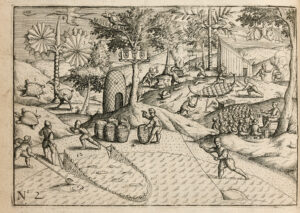Amsterdam, Corneille Nicolas, 1601.
Folio [320 x 230 mm] of (1) l., 21, (8) ll. for the Appendice, 27 figures engraved in the text including 22 half-page. Small restoration in the upper corner of leaf 7 and in the lower white margin of l. 16 not affecting the text. A few minor waterstains in the margin. Fawn quarter-calf, lengthwise gilt title. Binding towards 1900.
Very rare first French edition of the account of the second Dutch expedition to the East Indies (1598-1600), which allowed the Dutch to establish their commercial network in Mauritius, Madura, Celebes, Ambon, Ternate, Bantam…
Brunet, Supp. I, 704; Tiele 786; Alden/ Landis 611/ 68; Adams L1397; Howgego N14; Landwehr, VOC 252, 6.
“Precious collection of these extremely rare pieces, illustrated with very peculiar copperplates […] The first two books are attributed to Wilhelm Lodewijcksz or to François de Houtman.” (Chadenat, 6097, concerning his copy that included 5 works of which this one).
The Appendix bound after contains one of the first records of the languages spoken in the visited lands, with a Javanese lexicon and another one for the “Malayte language used everywhere in the East Indies”.
“Besides the merit of a few marine maps of which is enlarged this relation, it is very interesting again for the truthful character of his author, and for the notions it provides on the inhabitants of several parts of India, not a long after the discovery of this country by the Portuguese.” (Boucher de la Richarderie, Bibliothèque universelle des voyages, V, p. 10)
Jacques-Corneille Neck (1564-1638) was at the controls of the fleet composed of eight vessels which left Texel in March 1598. The Admiral Warwick was by his sides to assist him in this expedition. In the month of September 1598, they discovered and named Mauritius. In November of the same year, the vessels arrived in the harbor of Bantam where they traded with the natives. A part of the fleet reached the Moluccas, Madura, Java, Celebes, Madagascar, the Banda Islands, Ambon, Ternate… They establish then the first trading post of the East India Company. The vessels are back in Amsterdam in the summer of 1600.
This travel led to the creation, in 1602, of the Dutch East India Company, which will be for nearly two decades one of the pillars of the capitalist power and of the Dutch imperialism.
Precious copy of this very rare relation of the Dutch expedition to the East Indies in the last year of the 16th century.

![Le Second Livre, Journal ou Comptoir, Contenant le vray discours et narration historique, du voiage faict par les huict Navires d’Amsterdam, au mois de Mars l’An 1598, sous la conduite de l’Admiral Jaques Corneille Necq... [-Appendice, Vocabulaire des mots Javans et Malayts].](https://www.camillesourget.com/wp-content/uploads/2024/09/Neck-pl3-scaled.jpg)
![Le Second Livre, Journal ou Comptoir, Contenant le vray discours et narration historique, du voiage faict par les huict Navires d’Amsterdam, au mois de Mars l’An 1598, sous la conduite de l’Admiral Jaques Corneille Necq... [-Appendice, Vocabulaire des mots Javans et Malayts]. - Image 2](https://www.camillesourget.com/wp-content/uploads/2024/09/018-B_BT131621_036.jpg)
![Le Second Livre, Journal ou Comptoir, Contenant le vray discours et narration historique, du voiage faict par les huict Navires d’Amsterdam, au mois de Mars l’An 1598, sous la conduite de l’Admiral Jaques Corneille Necq... [-Appendice, Vocabulaire des mots Javans et Malayts]. - Image 3](https://www.camillesourget.com/wp-content/uploads/2024/09/Neck-pl2-scaled.jpg)
![Le Second Livre, Journal ou Comptoir, Contenant le vray discours et narration historique, du voiage faict par les huict Navires d’Amsterdam, au mois de Mars l’An 1598, sous la conduite de l’Admiral Jaques Corneille Necq... [-Appendice, Vocabulaire des mots Javans et Malayts]. - Image 4](https://www.camillesourget.com/wp-content/uploads/2024/09/Neck-titre-scaled.jpg)
![Le Second Livre, Journal ou Comptoir, Contenant le vray discours et narration historique, du voiage faict par les huict Navires d’Amsterdam, au mois de Mars l’An 1598, sous la conduite de l’Admiral Jaques Corneille Necq... [-Appendice, Vocabulaire des mots Javans et Malayts]. - Image 5](https://www.camillesourget.com/wp-content/uploads/2024/09/Reliure-1-scaled.jpg)